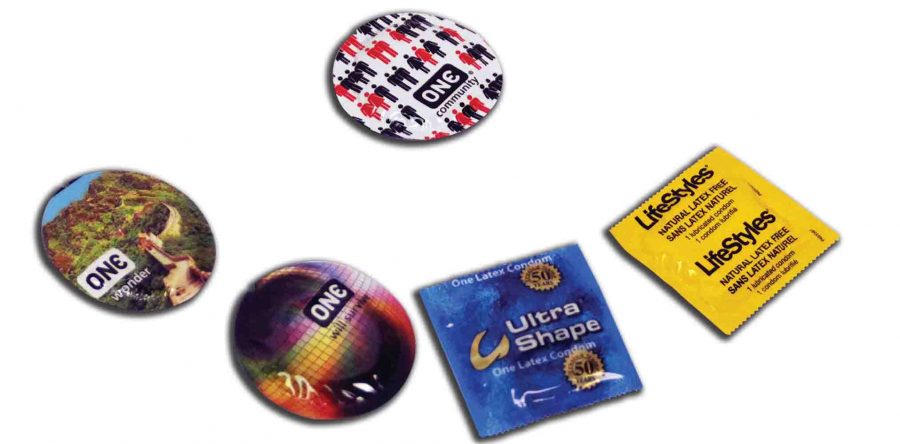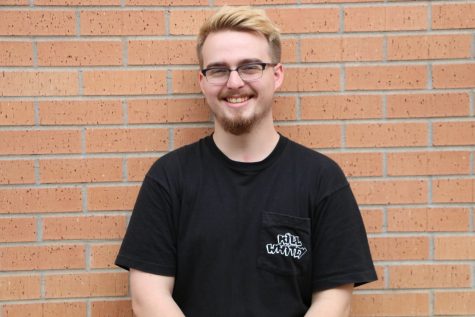Condoms added to health office
State and county health departments bring condoms to Lawrence High School after approval of school board
October 20, 2016
Condoms are just steps away from students now, after the district agreed to place them in the nurse’s office bathroom.
The move was a combined effort of the Douglas County Health Department (DCHC), the Kansas Department of Health and Environment (KDHE) and the school board. Condom dispensers were to be installed in the nurse’s office bathrooms during the weekend at both high schools.
The condoms are an extension of the comprehensive sexual education program implemented in 2013 that school board member Vanessa Sanburn has participated in and advocated for.
“Part of my work on the school board has been to improve sexuality education that students receive and so it was something obviously that I was particularly interested in,” Sanburn said.
The DCHC’s health promotion specialist, Michael Showalter, spoke to the board on Sept. 26 in support of condom availability in public high schools. The condom project is among other projects the DCHC has worked on with Lawrence Public Schools.
“We have an ongoing collaboration with the school district,” Showalter said in an interview. “We work with them on a number of different programs and initiatives within the community and as part of the district’s comprehensive sexuality education that they adopted in 2013. They were just looking to expand the sexuality education that they already provide. And one thing that they approached us about was making condoms available to high school students at both high schools here in Lawrence.”
Showalter believes that taking money and travel out of the equation will allow condoms to be used more often as those barriers will no longer stand between students and barrier birth control.
“One thing we talk about with making condoms available in the high schools is kind of, preventing those additional barriers to access,” Showalter said. “So, we know that youth already have a lot of trouble getting condoms, and just sexually active youth — people who are already choosing to have sex — have a lot of difficulty getting condoms. If it’s embarrassment, or cost, or they don’t have transportation to go to the store to buy them, and even though we make them available at the health department, how many people are going to travel to the health department just to get them? So, having condoms available to students who are already having sex just makes sense.”
The condoms are available in the health office restroom in a plastic container mounted on the wall to allow students to access the condoms privately. The containers were supplied by the KDHE, but the condoms themselves are being provided by the DCHD. Nurse Carol Casteel said the ideal times for students to get the condoms will be before and after school.
“We’re going to be meeting in the next few weeks to kind of just get the specifics of where exactly they’re gonna be,” Casteel said. “But I was pretty sure they were just gonna be here in the health office restroom. So probably something like before school and after school, because a lot of students need to use the restroom, some with wheelchairs or [who] come in here for their medications.”
Though hormonal birth control, such as the pill, can prevent pregnancy, it cannot protect against sexually transmitted diseases and infections. Showalter said that though teen pregnancy rates are going down, rates of STD’s and STI’s, specifically chlamydia, gonorrhea and syphilis, are rising.
“That’s actually a statewide trend and actually a national trend,” he said. “Nationally, they’re continuing to see decreased levels of teen pregnancy, but STD’s and STI’s are increasing in ages 13-24, and pretty dramatically in some places. Northeast Kansas, I can say, in this past year alone saw a record number of syphilis cases, in particular amongst youth.”
Beyond Sanburn’s work to further comprehensive sexuality education in Lawrence Schools, she teamed up with DCHD nurse Cori Green recently to start an organization to teach students about safe sex. The pair have been working together to educate teens for three years at Lawrence High, and, after expanding to Free State High School one year later, began doing their presentations at Tonganoxie High School this year.
“I have a masters degree in social work and I think we help provide a good balance between the types of questions or concerns that students were having,” Sanburn said. “It’s not always medical questions, sometimes it’s social and emotional questions where students want help kind of working through. We provide a good balance of helping students figure out and contemplate some of the pinnacle decision-making things that they need to think through when they’re contemplating relationships and all sorts of things in addition to sexual experiences.”
Sanburn said that parents have expressed discomfort about condom availability, but that the data shows that communication can ease this discomfort.
“Studies show that parents who have conversations with their kids about values and about remaining abstinent from sexual activity, that really makes a difference and it helps students to make healthy choices and to delay their sexual experiences,” Sanburn said. “So I would encourage any parents with any concerns about access to have those tough conversations and explain their values and expectations to their students because that is going to help their students more than anything else that they might do.”
Though parents have expressed concerns about the school board enabling sexual activity by providing condoms, even prompting a letter to the editor of the Lawrence Journal-World, Showalter said that providing condoms increases the number of students using them, not the number of students having sex.
“We know, as a public health department — and this is how we presented it to the school board as well — that condom availability does not increase sexual activity, and we know that nationwide it’s been proven for the last 30 years, actually, they’ve been collecting data on that,” he said. “The only thing you see with condom availability programs is an increase in the number of students using condoms, so students who are already choosing to have sex are going to continue to have sex. Students who are not having sex don’t increase in sexual activity just because they have access to condoms. ”
















